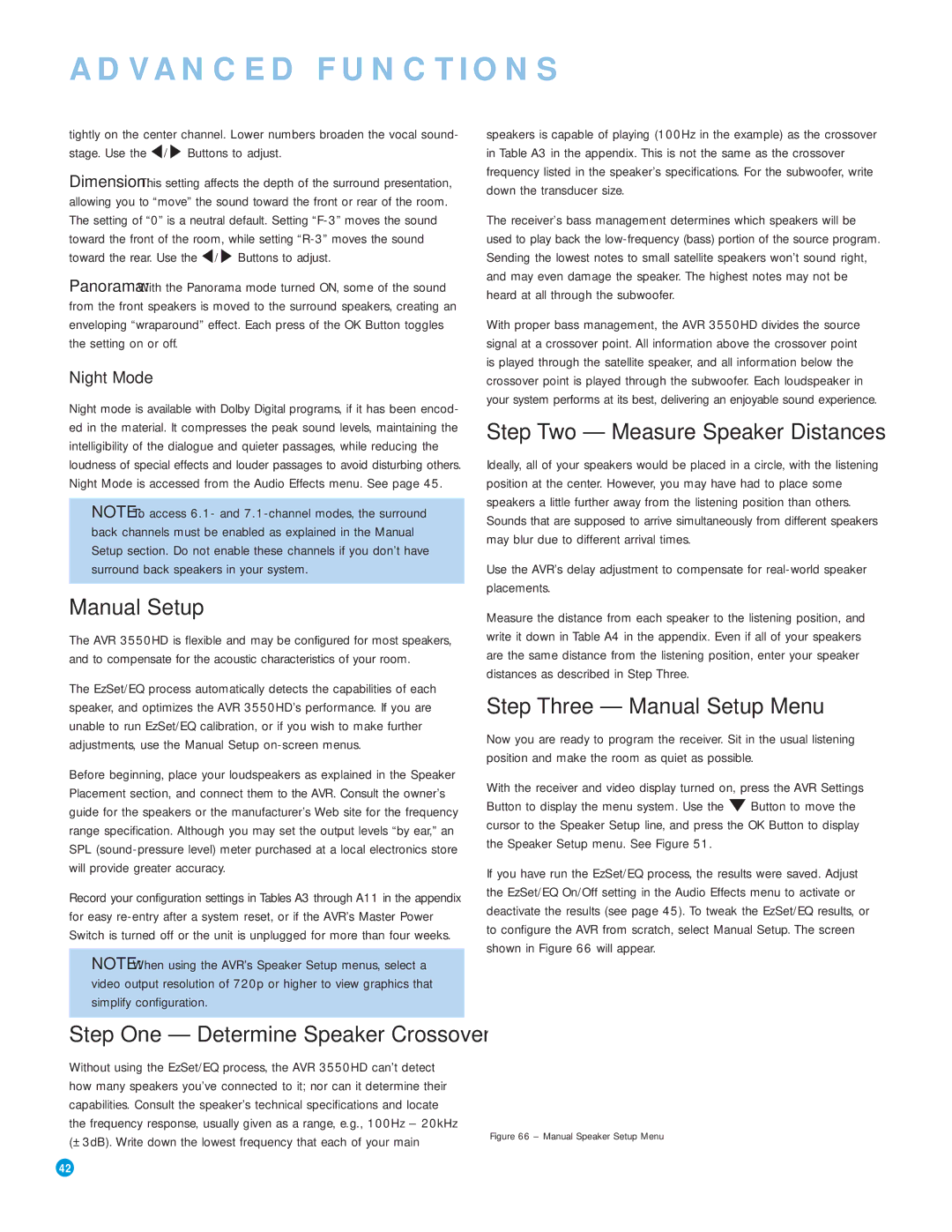
ADVANCED FUNCTIONS
tightly on the center channel. Lower numbers broaden the vocal sound- stage. Use the ‹ / › Buttons to adjust.
Dimension: This setting affects the depth of the surround presentation, allowing you to “move” the sound toward the front or rear of the room. The setting of “0” is a neutral default. Setting
Panorama: With the Panorama mode turned ON, some of the sound from the front speakers is moved to the surround speakers, creating an enveloping “wraparound” effect. Each press of the OK Button toggles the setting on or off.
Night Mode
Night mode is available with Dolby Digital programs, if it has been encod- ed in the material. It compresses the peak sound levels, maintaining the intelligibility of the dialogue and quieter passages, while reducing the loudness of special effects and louder passages to avoid disturbing others. Night Mode is accessed from the Audio Effects menu. See page 45.
NOTE: To access 6.1- and
speakers is capable of playing (100Hz in the example) as the crossover in Table A3 in the appendix. This is not the same as the crossover frequency listed in the speaker’s specifications. For the subwoofer, write down the transducer size.
The receiver’s bass management determines which speakers will be used to play back the
With proper bass management, the AVR 3550HD divides the source signal at a crossover point. All information above the crossover point is played through the satellite speaker, and all information below the crossover point is played through the subwoofer. Each loudspeaker in your system performs at its best, delivering an enjoyable sound experience.
Step Two – Measure Speaker Distances
Ideally, all of your speakers would be placed in a circle, with the listening position at the center. However, you may have had to place some speakers a little further away from the listening position than others. Sounds that are supposed to arrive simultaneously from different speakers may blur due to different arrival times.
Use the AVR’s delay adjustment to compensate for
Manual Setup
The AVR 3550HD is flexible and may be configured for most speakers, and to compensate for the acoustic characteristics of your room.
The EzSet/EQ process automatically detects the capabilities of each speaker, and optimizes the AVR 3550HD’s performance. If you are unable to run EzSet/EQ calibration, or if you wish to make further adjustments, use the Manual Setup
Before beginning, place your loudspeakers as explained in the Speaker Placement section, and connect them to the AVR. Consult the owner’s guide for the speakers or the manufacturer’s Web site for the frequency range specification. Although you may set the output levels “by ear,” an SPL
Record your configuration settings in Tables A3 through A11 in the appendix for easy
NOTE: When using the AVR’s Speaker Setup menus, select a video output resolution of 720p or higher to view graphics that simplify configuration.
Step One – Determine Speaker Crossover
Without using the EzSet/EQ process, the AVR 3550HD can’t detect how many speakers you’ve connected to it; nor can it determine their capabilities. Consult the speaker’s technical specifications and locate the frequency response, usually given as a range, e.g., 100Hz – 20kHz (±3dB). Write down the lowest frequency that each of your main
Measure the distance from each speaker to the listening position, and write it down in Table A4 in the appendix. Even if all of your speakers are the same distance from the listening position, enter your speaker distances as described in Step Three.
Step Three – Manual Setup Menu
Now you are ready to program the receiver. Sit in the usual listening position and make the room as quiet as possible.
With the receiver and video display turned on, press the AVR Settings Button to display the menu system. Use the ¤ Button to move the cursor to the Speaker Setup line, and press the OK Button to display the Speaker Setup menu. See Figure 51.
If you have run the EzSet/EQ process, the results were saved. Adjust the EzSet/EQ On/Off setting in the Audio Effects menu to activate or deactivate the results (see page 45). To tweak the EzSet/EQ results, or to configure the AVR from scratch, select Manual Setup. The screen shown in Figure 66 will appear.
Figure 66 – Manual Speaker Setup Menu
42
